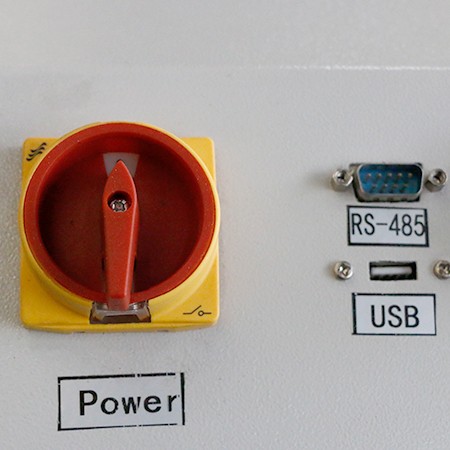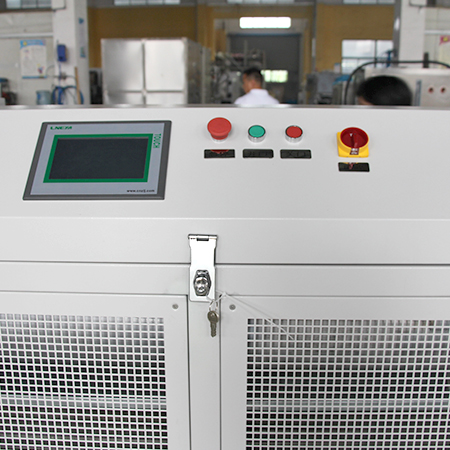What Is Chiller Voltage And How To Select
In der industriellen Produktion sind Chiller wichtige Temperaturregelgeräte. Viele Käufer achten auf Kühlleistung, Temperaturgenauigkeit und Marke. Aber sie übersehen oft einen entscheidenden Punkt — die Spannung. Manche denken vielleicht: „Ist es nicht einfach Plug-and-Play?“ Nicht wirklich. Wenn die Spannung nicht passt, kann der Chiller nicht starten. Dies kann auch zu Kompressorüberlastung, Beschädigung des Steuersystems und sogar zu Sicherheitsrisiken für die gesamte Produktionslinie führen. Was ist also Spannung? Und wie wählt man die richtige Chiller-Spannung aus?
Was ist die Chiller-Spannung?
Die Chiller-Spannung ist das Maß an elektrischer Energie, das der Chiller benötigt, um ordnungsgemäß zu funktionieren. Sie beeinflusst, ob der Chiller starten und reibungslos laufen kann. Sie wirkt sich auch auf die Sicherheit der elektrischen Bauteile und die Lebensdauer des Chillers aus. Man kann es mit dem Blutdruck eines Menschen vergleichen — man braucht den richtigen Bereich, um gesund zu bleiben. Zu niedrige Spannung ist wie Sauerstoffmangel, wodurch der Kompressor schwer startet und die Kühlleistung sinkt. Zu hohe Spannung ist wie Überdruck auf das Herz, wodurch Bauteile überhitzen, die Isolierung verschleißt und Steuerplatinen ausbrennen.

Gängige Chiller-Spannungstypen
Gängige Chiller-Spannungen sind Einphasen-Wechselstrom, Dreiphasen-Wechselstrom und kundenspezifische Spannungen
Einphasen-Wechselstrom
Einphasenstrom ist typisch für kleine Chiller. Diese Chiller werden in Laboren, medizinischen Geräten oder in der Leichtindustrie eingesetzt. In Nordamerika laufen sie oft mit 110V oder 120V/60Hz. In China beträgt die übliche Spannung 220V/50Hz. Einphasige Chiller lassen sich einfach anschließen — einfach in eine Standardsteckdose stecken. Sie eignen sich gut für geringfügigen Strombedarf.
Einphasenstrom kann jedoch bei langen, schweren Lasten Probleme bereiten. Die Spannung kann schwanken und die Kühlstabilität beeinträchtigen. Viele Labore beginnen mit einphasigen Chillern, wechseln jedoch zu Dreiphasen, wenn ihre Wärmelast steigt.
Three-phase AC
Dreiphasenstrom ist die Hauptversorgung für mittelgroße bis große industrielle Chiller. In China ist 380V/50Hz üblich. Europa verwendet meist 400V/50Hz. Nordamerika nutzt oft 480V/60Hz. Dreiphasenstrom ist stabiler und kann große Kompressoren betreiben. Er eignet sich gut für lange, schwere Kühlaufgaben. Deshalb bevorzugen Pharma- und Chemieanlagen ihn.
Die Installation von Dreiphasen-Chillern erfordert qualifizierte Elektriker. Außerdem wird ausreichende Leistungskapazität vor Ort benötigt.
Kundenspezifische Spannung
Einige Chiller verwenden kundenspezifische Spannungen für den Export oder globale Werke. Zum Beispiel benötigen Teile der USA 208V/
| Region | Common Single-phase Voltage | Common Three-phase Voltage |
| North America | 120V / 60Hz | 208V, 230V, 460V |
| Europe/Asia | 220-240V / 50Hz | 380V, 400V, 415V |
| China | 220V / 50Hz | 380V / 50Hz |
Wie beeinflusst die Spannung einen Chiller?
Inbetriebnahme der Ausrüstung
Wenn die Spannung nicht mit der Nennspannung des Chillers übereinstimmt, kann das Gerät überhaupt nicht starten. Zum Beispiel startet ein 380V-Drehstrom-Chiller nicht, wenn man ihn an eine einphasige 220V-Stromversorgung anschließt. Andererseits, wenn ein 220V-Chiller an 380V angeschlossen wird, können elektrische Teile sofort durchbrennen und sogar ein Brand entstehen.

Betriebsstabilität
Industrial chillers sind bei hohen Lasten empfindlich gegenüber Spannungsänderungen. Niedrige Spannung erschwert das Anlaufen des Kompressors und kann häufige Überlastabschaltungen verursachen, was im Laufe der Zeit zu Überhitzung und Isolationsschäden führt. Hohe Spannung beschleunigt den Verschleiß von Motoren und Steuerungssystemen und verkürzt die Lebensdauer des Chillers.
Kühlleistung
Die Geschwindigkeit von Kompressoren und Pumpen hängt stark von der Spannung ab. Liegt die Spannung unter dem Nennwert, sinkt die Kühlleistung, die Temperaturerholung dauert länger, und der Chiller kann die Solltemperaturen möglicherweise nicht halten. Hohe Spannung kann die Geschwindigkeit vorübergehend erhöhen, steigert jedoch den Energieverbrauch und führt zu schnellerem mechanischem Verschleiß.
Sicherheit
Hohe Spannung, Phasenausfall oder falsche Phasenfolge können elektrische Fehler im Chiller verursachen. Dies kann zu Kurzschlüssen, Geräteschäden oder Bränden führen. Die meisten Chiller verfügen über integrierte Schutzfunktionen wie Überspannungs-, Unterspannungs-, Phasenausfall- und Phasenfolgenalarme. Diese Sicherheitsfunktionen verringern zwar Risiken, ersetzen jedoch keine korrekte Spannungsanpassung.
How to Choose the Right Voltage?
Choosing the right chiller voltage means matching your site’s power supply while meeting the chiller’s needs.
Stromversorgung vor Ort
Wenn Ihre Fabrik oder Ihr Labor nur eine einphasige 120V-Versorgung hat, ist die Wahl eines einphasigen 120V-Chillers die einfachste Lösung. Viele kleine Labore, medizinische Einrichtungen oder leichte Industriebetriebe fallen in diesen Fall. Der Kauf eines dreiphasigen 230V-Chillers funktioniert ohne zusätzliche Transformatoren nicht – und das ist teuer.
Chiller-Leistung
Je größer der Chiller, desto mehr Leistung benötigt er. In der Regel können Chiller unter 5 kW einphasigen Strom verwenden. Die meisten industriellen Chiller über 10 kW benötigen jedoch Drehstrom, um Kompressoren und Pumpen zuverlässig zu betreiben.


Leistungsstandards
Different countries have different industrial voltage standards. For example, the US often uses three-phase 208V or 460V, Japan has a 200V system, and Europe mostly uses three-phase 400V. For exports or multinational sites, it’s best to choose chiller manufacturers (like LNEYA) who support custom voltages to avoid power mismatch during installation.
Zukünftige Anforderungen
Viele Unternehmen kaufen zunächst einen Chiller für ein kleines Gerät. Später, bei Erweiterungen oder Prozessänderungen oder beim Hinzufügen größerer Reaktoren, reicht die Leistung und Spannung möglicherweise nicht aus. Dann müssen neue Chiller gekauft werden. Wenn dies wahrscheinlich ist, ist es klüger, mit einem dreiphasigen Chiller zu beginnen, der höhere Leistung unterstützt.
Schlussfolgerung
Egal, ob Sie einphasige oder dreiphasige Chiller benötigen, LNEYA bietet professionelle Lösungen. Wir decken gängige Spannungen ab und können die Spannungsspezifikationen basierend auf Ihrer Stromversorgung und den lokalen Standards anpassen. Dies stellt sicher, dass Ihre Geräte sofort einsatzbereit sind und stabil laufen. Wählen Sie LNEYA, um Ihr Kühlsystem zuverlässiger zu machen.
FAQ

- Temperature Control in Photolithography
- Is a Used Chiller a Good Idea
- Chiller Components and Refrigeration Fundamentals Guides
- Chiller Types and Selection Guides
- Dezember 2025
- November 2025
- Oktober 2025
- September 2025
- August 2025
- Juli 2025
- Juni 2025
- Mai 2025
- März 2025
- Februar 2025
- Januar 2025
- Dezember 2024
- November 2024
- Oktober 2024
- September 2024
- August 2024
- Juli 2024
- Juni 2024
- Mai 2024
- April 2024
- März 2024
- Februar 2024
- September 2023
- Juli 2023
- Juni 2023
- Mai 2023
- Januar 2023
luftgekühlte Kältemaschine Kühler Installation der Kältemaschine Wartung von Kühlanlagen chiller refrigerant Kältemaschinen Kalte Montage Gefrierschrank Kaltwassersatz Kühl-Heizsystem cooling system dynamisches Temperaturkontrollsystem energieeffizienter Chiller explosionsgeschützter Kühler Gefrierschrank Heizungsumwälzpumpe Industriekühler Industriekälteanlagen Industriekühlung industrieller Gefrierschrank Industriekühlschrank Mantelreaktor Laborkühlschrank Niedertemperaturkühler Nachrichten Ölkühler Prozesskühler process cooling Reaktorkühler Reaktorkühlung Reaktorkühlung Heizung Reaktorheizung Kühlung Kältethermostat Schneckenkühler Halbleiter-Kühlgerät Halbleiter-Testkühler sundi tcu Temperaturkontrolle Prüfkammer Thermostat Ultra-Niedertemperatur-Kühler Fahrzeug-Test-Kühler Kaltwassersatz wassergekühlte Kältemaschine
Verwandte Kühlgeräte
KONTAKT US
TEL:
EMAIL:
WeChat & WhatsApp:

Wechat QR

Haben Sie eine Frage oder benötigen Sie ein Angebot? Füllen Sie das untenstehende Formular aus, und unser Team wird sich innerhalb von 24 Stunden bei Ihnen melden.
 LNEYA Industriekühler Hersteller Lieferant
LNEYA Industriekühler Hersteller Lieferant
















